ESP MERCEDES-BENZ SLC 2020 User Guide
[x] Cancel search | Manufacturer: MERCEDES-BENZ, Model Year: 2020, Model line: SLC, Model: MERCEDES-BENZ SLC 2020Pages: 310, PDF Size: 16.05 MB
Page 45 of 310
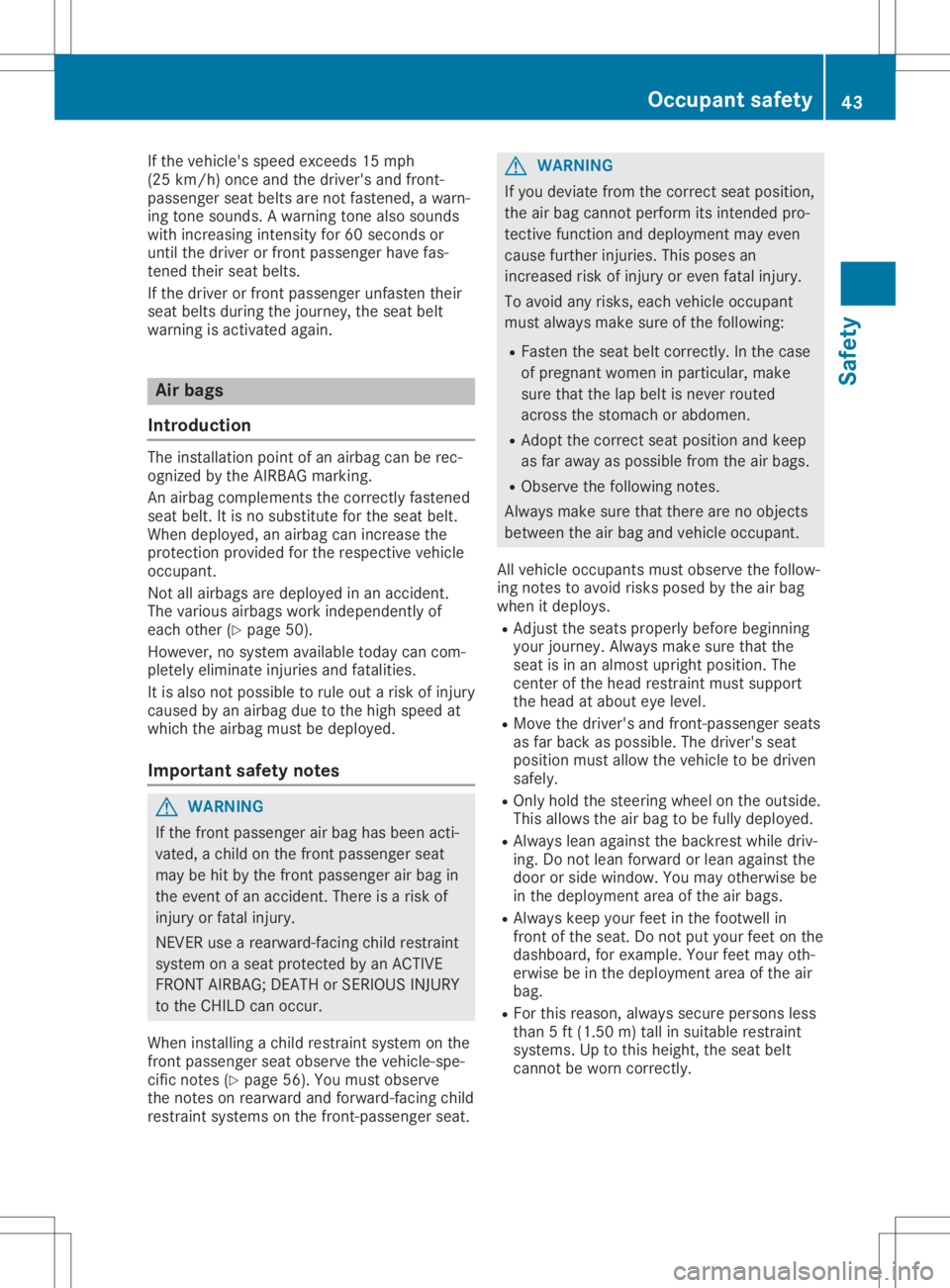
If
the vehicle 'sspeed exceeds 15mph
(25 km/h) onceandthedriver's andfront-
passe ngerseatbelts arenot fastened, awarn-
ing tone sounds. Awarning tonealsosounds
with increasing intensityfor60seconds or
until thedriver orfront passe ngerhave fas-
tened theirseatbelts.
If the driver orfront passe ngerunfasten their
seat belts duringthe journey, theseat belt
warning isactivated again. Air
bags
Introductio n The
installa tionpoint ofan airb agcan berec-
ognized bythe AIRBAG marking.
An airb agcomplements thecorrectly fastened
seat belt. Itis no substitu tefor the seat belt.
When deployed ,ana irbag can increase the
protection providedfor the respective vehicle
occupant.
Not allairb ags aredepl oyed inan accident.
The variou sairbags work indepe ndently of
each other (Ypage 50).
However, nosystem availabletoday cancom-
pletel yelimi nate injuries andfatali ties.
It is also notpossib leto rule outarisk ofinjury
cause dbyana irbag due tothe high speed at
which theairbagmust bedepl oyed .
Important safetynotes G
WARNING
If the front passe ngerairbag hasbeen acti-
vated, achild onthe front passe ngerseat
may behit bythe front passe ngerairbag in
the event ofan accident. Thereisar isk of
injury orfatal injury.
NEVER usearearwa rd-facing childrestraint
system onaseat protected byan ACTIVE
FRONT AIRBAG; DEATHorSERIOUS INJURY
to the CHILD canoccur.
When installi ngachild restraint systemonthe
front passe ngerseatobserve thevehicle -spe-
cific notes (Ypage 56).Youmust observe
the notes onrearwa rdand forward -facingchild
restraint systemsonthe front-passenger seat. G
WARNING
If you devia tefrom thecorrect seatpositio n,
the airbag cannot perform itsintended pro-
tective function anddeployment mayeven
cause further injuries. Thisposes an
increased riskofinjury oreven fatalinjury.
To avoid anyrisks, eachvehicle occupant
must always make sureofthe follow ing:
R Fasten theseat beltcorrectly. Inthe case
of pregnant womeninparticul ar,make
sure thatthelapbelt isnever routed
across thestomach orabdo men.
R Adopt thecorrect seatpositio nand keep
as far awa yasp ossib lefrom theairbags.
R Observe thefollow ingnotes.
Alway smake sure thatthere arenoobjects
betwee nthe air bag and vehicle occupant.
All vehicle occupants mustobserve thefollow -
ing notes toavoid risksposed bythe airbag
when itdepl oys.
R Adjust theseats properl ybefore beginning
you rjourney. Alwaysmake sure thatthe
seat isin an almos tupright positio n.The
center ofthe head restraint mustsupport
the head atabou teye level .
R Move thedriver's andfront-passenger seats
as far back aspossib le.The driver's seat
positio nmustallow the vehicle tobe driven
safel y.
R Only holdthesteering wheelonthe outsid e.
This allows theairbag tobe fullydepl oyed .
R Alway slea na gainst thebackrest whiledriv-
ing. Donot leanforward orlea na gainst the
door orside window .You may otherwise be
in the depl oyment areaofthe airbags.
R Alway skeep yourfeet inthe footwell in
front ofthe seat. Donot putyourfeet onthe
dashb oard,forexample .Your feet may oth-
erwis ebeint he depl oyment areaofthe air
bag.
R For this reason, always secure persons less
than 5ft(1.50 m)tall insuita blerestraint
systems. Uptothis heigh t,the seat belt
cannot beworn correctly. Occ
upant safety
43Safety Z
Page 46 of 310
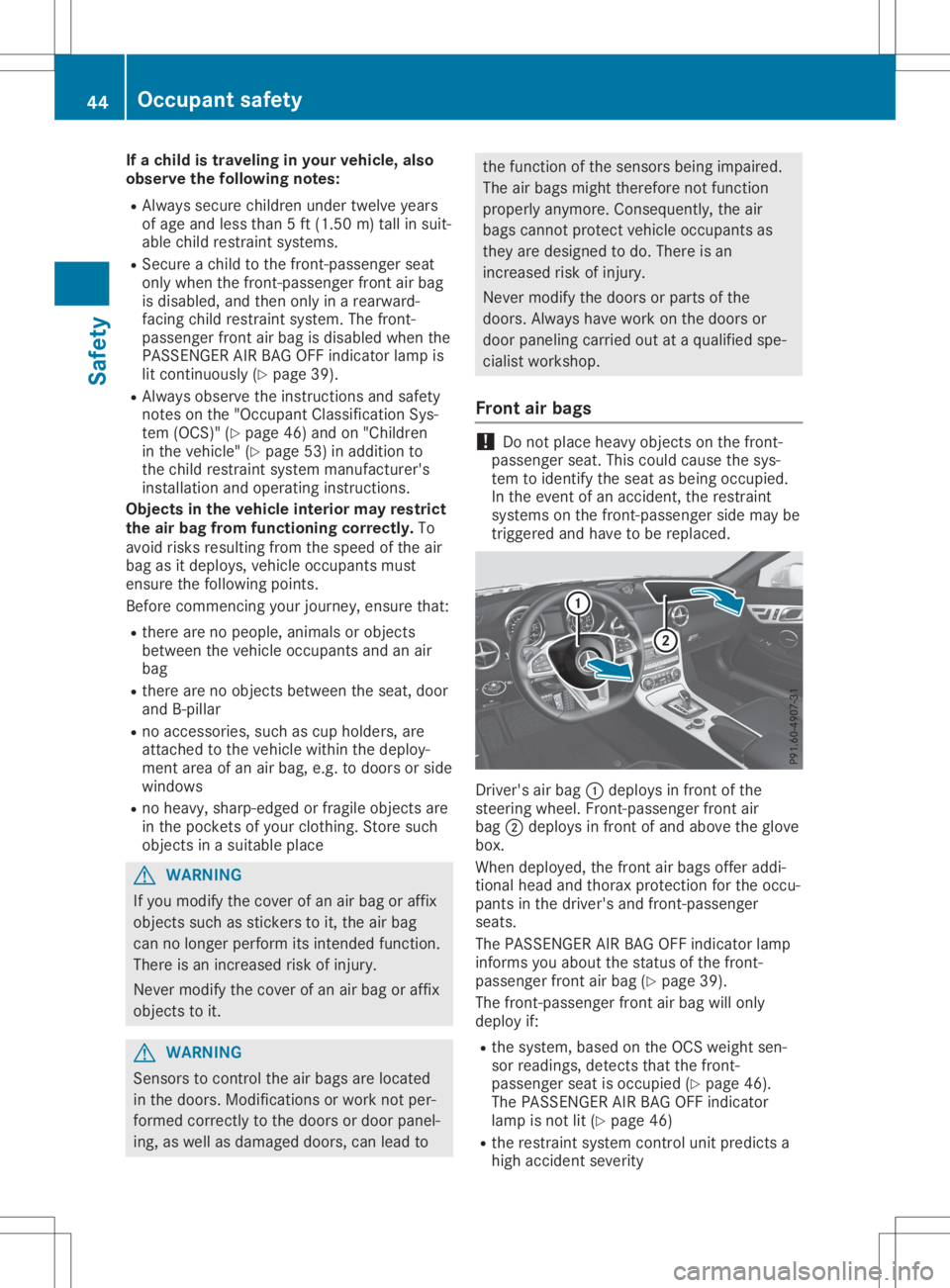
If
ac hild istravel inginyou rvehi cle, also
obser vethef ollowi ngnot es:
R Always secure childre nunde rtwe lve years
of age and less than 5ft(1.5 0m )tallins uit-
ab lechi ldres traint syste ms.
R Secu reac hild to the front-pa ssenge rseat
onl yw hent he front-pa ssenge rfront airb ag
is disa bled ,and the nonlyi nar earw ard-
fa cing childres traint syste m. The front-
pa sse nge rfront airb ag isdisa bled when the
PASSEN GERAIRBAG OFFindicator lamp is
li tc onti nuously(Y page 39).
R Alw ayso bserve the instructio nsand safety
note sonthe "Occu pant Clas sific ati on Sys -
tem (OCS) "(Y pa ge 46) and on"Child ren
in the vehicle" (Y page 53)ina dditio nt o
the childres traint syste mm anufactu rer's
ins tallatio na nd opera ting instructio ns.
Ob jec tsinthe vehic leinteri ormay restric t
the airbag fromf uncti oningc orrec tly.To
av oidr isks res ulting fromt hespee do fthe air
ba ga sitd eploys, veh icleo ccu pants must
ens uret he followi ng points .
Befo recomm encingyour jou rney ,ensuret hat:
R the rearen op eople, ani ma lsor objects
be twe enthe vehicleo ccu pants and anair
ba g
R the rearen oo bjects betwe enthe seat, door
and B-pillar
R no acc essor ies, su ch ascup holders, are
atta chedtothe veh iclew ithi nt he deploy -
ment area ofan airb ag,e .g.t od oors or side
wi ndo ws
R no heavy, sha rp-e dged orfra gile ob jects are
in the pockets ofyour clo thing. Store such
ob jects inas uita blep lace G
WA
RNING
If yo um odify the cove rofana irba go raffix
ob jects such assticker stoit,the airb ag
can nolonge rperform itsinte ndedfunctio n.
The reisan incr easedr isko finju ry.
Nev ermod ifythe cove rofana irba go raffix
ob jects toit. G
WA
RNING
Sens orstocontro lthe airb agsa relocate d
in the doors .M odificati ons orwo rknot per-
for med correctlytot he doors ordoor panel -
ing ,asw ella sd am aged doors ,can lead to the
functio nofthe senso rsbeing impaire d.
The airb agsm ight the refore not functio n
pro perly any mor e.Co nse quentl y,the air
ba gs cann otpro tect vehicleo ccu pants as
the yaredesigne dtod o.The reisan
incr easedr isko finju ry.
Nev ermod ifythe doors orparts ofthe
do ors .Alway sh avew orko nthe doors or
do or panel ing carriedo utataq ualifi ed spe-
cia list wo rksh op.
Fro ntair bag s !
Do
not place heavyo bjects onthe front-
pa sse nge rseat.Thi scouldcau sethe sys-
tem toidenti fythe seat as being occu pied .
In the eventofan acc ident, therestraint
sy ste ms onthe front-pa ssenge rsidem aybe
trig gered and have tobe rep laced . Dri
ver 'sairb ag 0043 deploy sinf ront ofthe
ste ering wheel.Fron t-passenge rfront air
ba g0044 deploy sinf ront ofand above theglove
bo x.
Wh endeploy ed ,the frontairb agso ffer addi-
tio nal head and thoraxpro tecti onfor the occu -
pa nts inthe driver 'sand front-pa ssenge r
se ats .
The PASSEN GERAIRBAG OFFindicator lamp
inf orm syou abou tthe status ofthe front-
pa sse nge rfront airb ag (Y pa ge 39).
The front-pa ssenge rfront airb ag willonl y
de ploy if:
R the syste m, basedo nthe OC Sw eigh ts en-
sor readings ,detects thatthe front-
pa sse nge rseatiso ccu pied (Ypage 46) .
The PASSEN GERAIRBAG OFFindicator
la mp isnot lit( Ypa ge46)
R the restraint syste mc ontro lunitp redicts a
hi gh acc ident sever ity 44
Oc
cupant safetySafe ty
Page 47 of 310
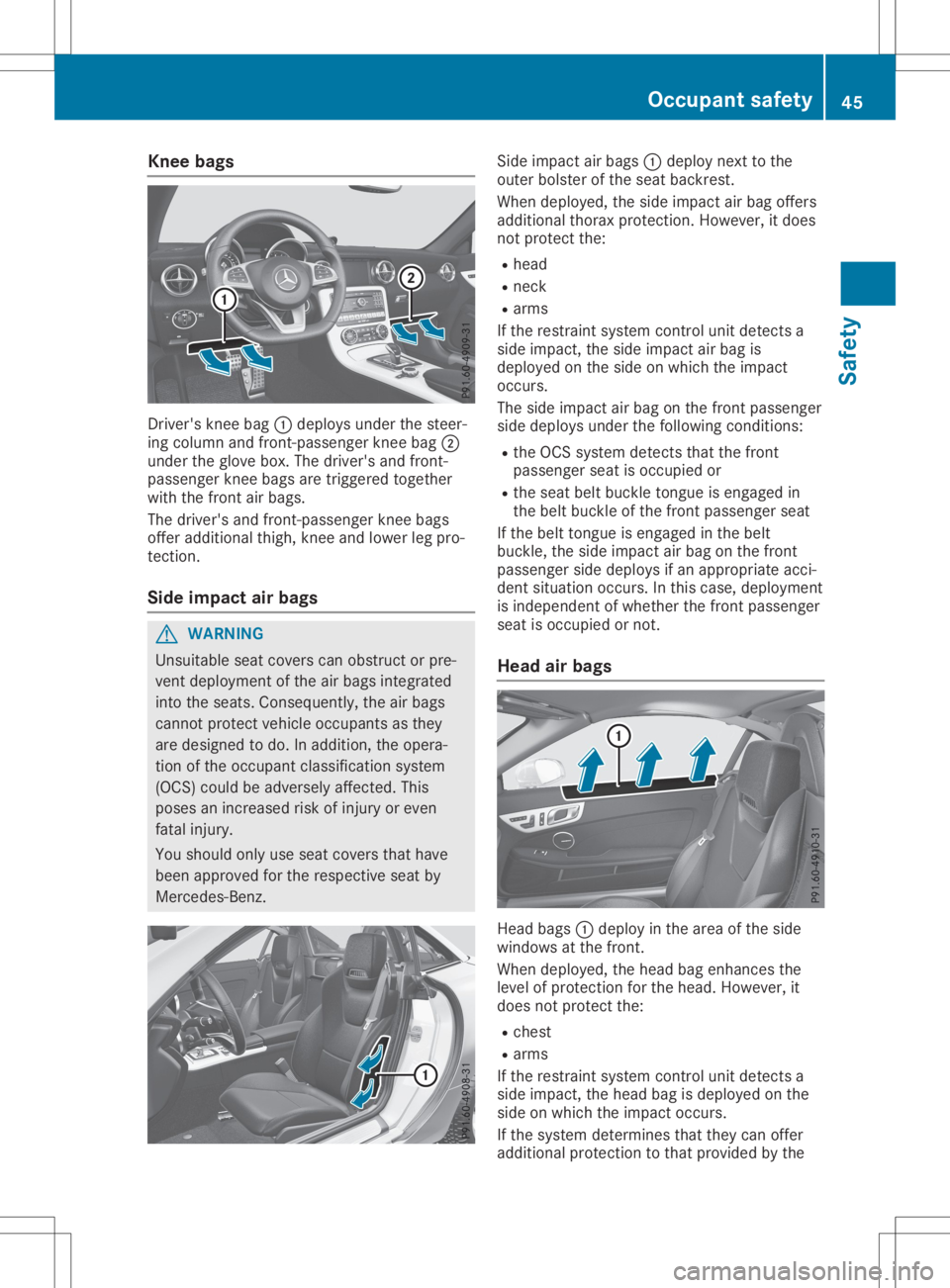
Knee
bags Dr
ive r'sk neeb ag0043 depl oysunderthes teer -
ing column andfron t-pass enger knee bag 0044
und ertheg loveb ox.T he driver 'sand fron t-
pass enger knee bags aretrigge redtoget her
wit hthe fron ta irbags .
The driver 'sand fron t-pass enger knee bags
off eraddit ionalthigh, knee and lower legpro-
te ction .
Sid eimp act airbag s G
WAR
NING
Un suit able seat cover scan obs truct orpre -
ven tdepl oyme ntofthea irbags integr ated
int ot he seat s.Con sequen tly, thea irbags
can notp rotect veh icleo ccup ant sasthey
are designed todo. Inaddit ion,the oper a-
ti on oftheo ccup ant clas sificat ion syst em
(OCS )cou ldbe adve rsely affected. This
pos esan increas edrisko finjury oreve n
fat alinj ury.
You should onlyuse seat cover sthath ave
been approvedfor ther espec tive seat by
Mer cedes -Ben z. Sid
eimp act airbags 0043depl oynext to the
out erbols tero fthe seat backrest .
Whe ndeployed, thes ide imp act airbag offers
addit ionalthora xprotection .How ever, itdoes
no tp rotect the:
R head
R ne ck
R arm s
If th er estrain tsyst em control unitdetec ts a
side impact,the side impact airbag is
depl oyed onthes ide onwhic hthe imp act
oc cur s.
The side impact airbag onthef ront pass enger
side deploysunderthef ollowin gcondition s:
R theO CS syst emdetects that thef ront
pass enger seat isoc cup iedor
R thes eat belt bucklet ongueise ngage din
th eb elt buc kleo fthe fron tp ass enger seat
If th eb elt tong ue isen gage dint he belt
buc kle, thes ide imp act airbag onthef ront
pass enger side deploysifan appr opriatea cci-
den tsituati onoccur s.In this cas e,depl oyme nt
is ind epen dentofw het her thef ront pass enger
seat isoc cup iedornot.
Hea dairbag s Hea
dbags 0043depl oyinthea rea ofthes ide
win dows atthef ront.
Whe ndeployed, theh ead bagenhan cest he
lev elof pro tection fortheh ead .How ever, it
does notp rotect the:
R ch est
R arm s
If th er estrain tsyst em control unitdetec ts a
side impact,the head bagisdepl oyed onthe
side onwhic hthe imp act occur s.
If th es yst em determ inesthatthe yc an offer
addit ionalpro tection tothat pro vided bythe Occup
antsafety
45Safet y Z
Page 49 of 310
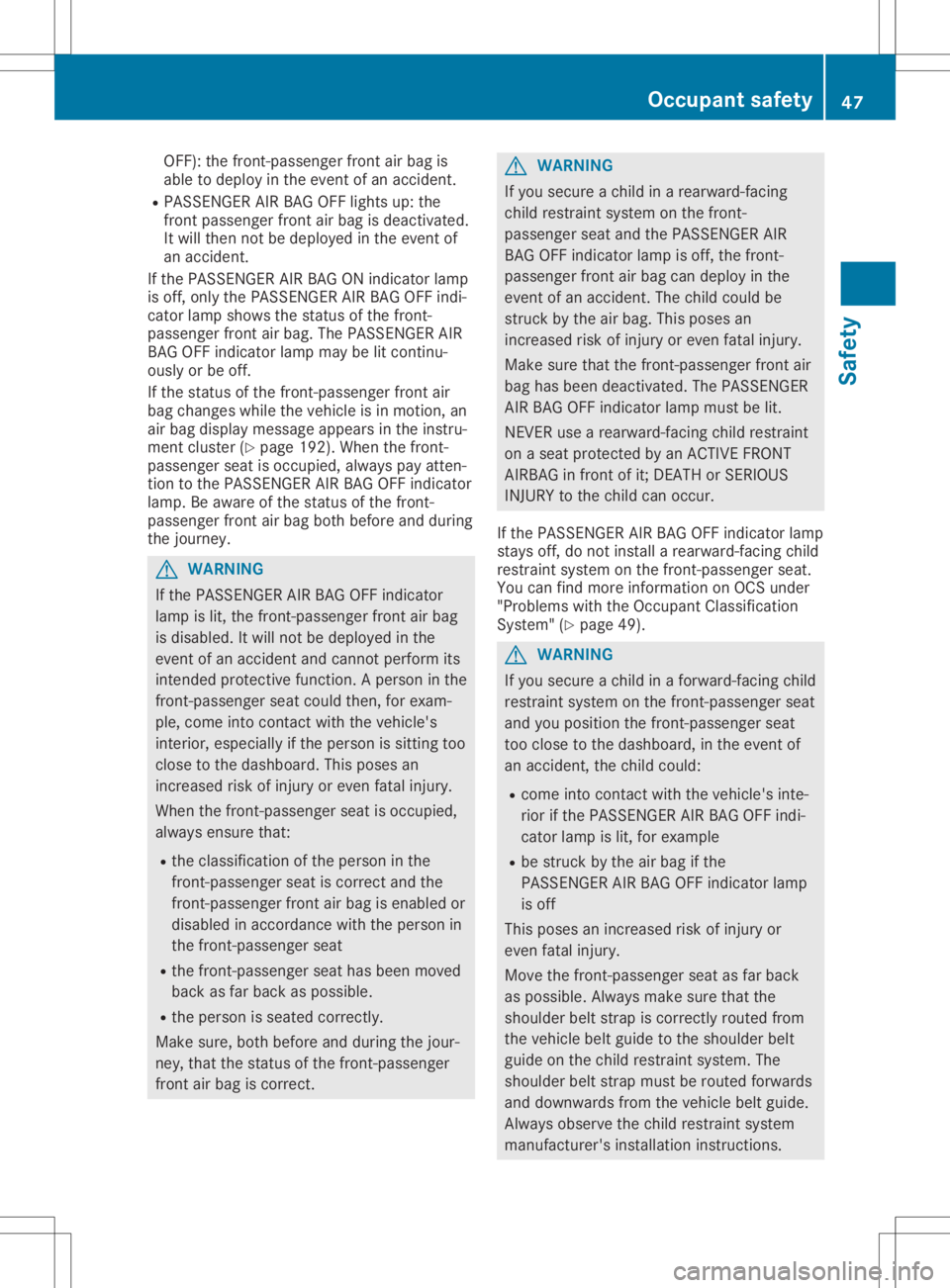
OFF):
thefront -passenger frontairbag is
able todeploy inthe event ofan accident.
R PASSE NGERAIRBAG OFFlights up:the
front passenger frontairbag isdeactivated.
It will then notbedeploy edinthe event of
an accident.
If the PASSE NGERAIRBAG ONindicator lamp
is off, only thePASSE NGERAIRBAG OFFindi-
cator lampshows thestatus ofthe front -
passenger frontairbag. ThePASSE NGERAIR
BAG OFFindicator lampmaybelitcont inu-
ously orbe off.
If the status ofthe front -passenger frontair
bag changes whilethevehicle isin motion, an
air bag displa ymessage appearsinthe instru-
ment cluster (Ypage 192). When thefront -
passenger seatisoccupied, alwayspay atten-
tion tothe PASSE NGERAIRBAG OFFindicator
lamp. Beawa reofthe status ofthe front -
passenger frontairbag both before andduring
the journey. G
WARNING
If the PASSE NGERAIRBAG OFFindicator
lamp islit, the front -passenger frontairbag
is disabl ed.Itwill notbedeploy edinthe
event ofan accident andcannot perform its
intended protective function.Aperson inthe
front -passenger seatcould then,forexam-
ple, come intocontactwith thevehicle's
interior, especiallyifthe person issitting too
close tothe dashboa rd.This poses an
increased riskofinjury oreven fatalinjury.
When thefront -passenger seatisoccupied,
alwa ysensure that:
R the classification ofthe person inthe
front -passenger seatiscorrect andthe
front -passenger frontairbag isenabled or
disabl edinaccordance withtheperson in
the front -passenger seat
R the front -passenger seathasbeen moved
back asfar back aspossible .
R the person isseated correctly.
Make sure,bothbefore andduring thejour-
ney, thatthestatus ofthe front -passenger
front airbag iscorrect . G
WARNING
If you secure achild inar earward-facing
child restraint systemonthe front -
passenger seatandthePASSE NGERAIR
BAG OFFindicator lampisoff, thefront -
passenger frontairbag candeploy inthe
event ofan accident. Thechild could be
struck bythe airbag. Thisposes an
increased riskofinjury oreven fatalinjury.
Make surethatthefront -passenger frontair
bag hasbeen deactivated. ThePASSE NGER
AIR BAG OFFindicator lampmust belit.
NEVER usearearward-facing childrestraint
on aseat protected byan ACTIVE FRONT
AIRBAG infront ofit;DEA THorSERIOUS
INJURY tothe child canoccur.
If the PASSE NGERAIRBAG OFFindicator lamp
stays off,donot install arearward-facing child
restraint systemonthe front -passenger seat.
You canfind more information onOCS under
"Proble mswith theOccupant Classification
System" (Ypage 49). G
WARNING
If you secure achild inaf orward-facing child
restraint systemonthe front -passenger seat
and youposition thefront -passenger seat
too close tothe dashboa rd,inthe event of
an accident, thechild could:
R come intocontactwith thevehicle's inte-
rior ifthe PASSE NGERAIRBAG OFFindi-
cator lampislit, for example
R be struck bythe airbag ifthe
PASSE NGERAIRBAG OFFindicator lamp
is off
This poses anincreased riskofinjury or
even fatalinjury.
Move thefront -passenger seatasfar back
as possible .Alway smake sure thatthe
shoulde rbelt strap iscorrect lyrouted from
the vehicle beltguide tothe shoulde rbelt
guide onthe child restraint system.The
shoulde rbelt strap mustberouted forwards
and downwards fromthevehicle beltguide .
Alway sobserve thechild restraint system
manufacturer's installationinstructions. Occ
upant safety
47Safety Z
Page 50 of 310
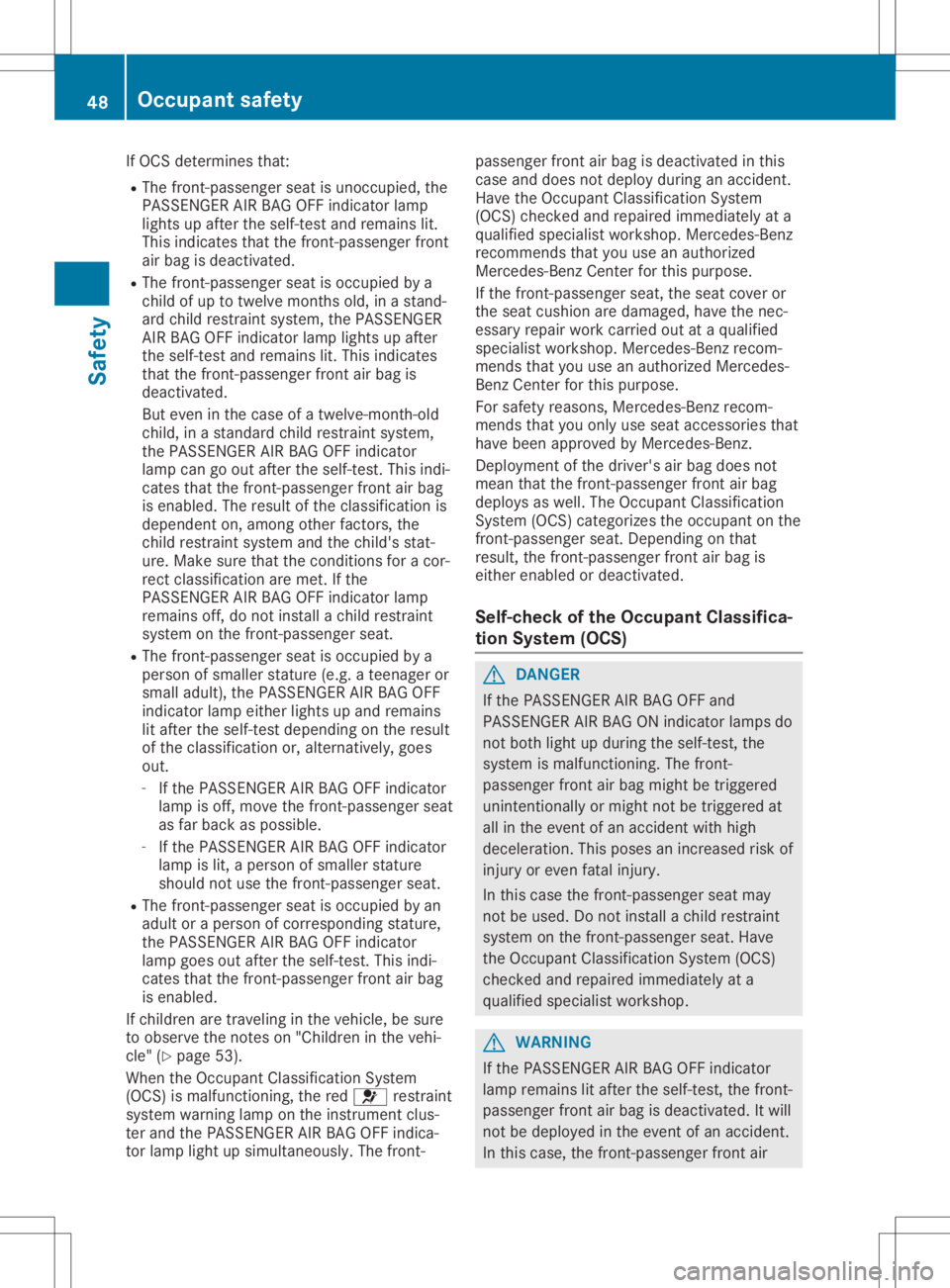
If
OCS determines that:
R The front-passenger seatisunoccupi ed,the
PASSENGER AIRBAG OFFindicator lamp
lights upafter theself-test andremains lit.
This indicates thatthefront-passenger front
air bag isdeactiva ted.
R The front-passenger seatisoccupie dbya
child ofup totwelve months old,inas tand-
ard child restraint system,thePASSENGER
AIR BAG OFFindicator lamplights upafter
the self-test andremains lit.This indicates
that thefront-passenger frontairbag is
deactiva ted.
But even inthe case ofat welve-month-old
child, inas tandard childrestraint system,
the PASSENGER AIRBAG OFFindicator
lamp cangoout after theself-test. Thisindi-
cates thatthefront-passenger frontairbag
is enabled. Theresul tofthe classi fication is
depende nton, among otherfactors, the
child restraint systemandthechild's stat-
ure. Make surethattheconditions foracor-
rect classi fication aremet. Ifthe
PASSENGER AIRBAG OFFindicator lamp
remains off,donot install achild restraint
system onthe front-passenger seat.
R The front-passenger seatisoccupie dbya
person ofsmall erstature (e.g.ateenager or
small adult),the PASSENGER AIRBAG OFF
indicator lampeither lightsupand remains
lit after theself-test dependingon the resul t
of the classi fication or,alternativel y,goes
out.
- Ifthe PASSENGER AIRBAG OFFindicator
lamp isoff, move thefront-passenger seat
as far back aspossib le.
- Ifthe PASSENGER AIRBAG OFFindicator
lamp islit, aperson ofsmall erstature
shoul dnotuse thefront-passenger seat.
R The front-passenger seatisoccupie dbyan
adu ltor ap erson ofcorresponding stature,
the PASSENGER AIRBAG OFFindicator
lamp goesoutafter theself-test. Thisindi-
cates thatthefront-passenger frontairbag
is enable d.
If childre naretraveling inthe vehicle ,bes ure
to observe thenotes on"Ch ildre nint he vehi-
cle" (Ypage 53).
When theOccupant Classifica tionSystem
(OCS) ismalfu nctioning, thered 0075 restraint
system warning lamponthe instrument clus-
ter and thePASSENGER AIRBAG OFFindica-
tor lamp lightupsimul taneousl y.The front- passe
ngerfront airbag isdeactiva tedinthis
case anddoes notdepl oyduri nganaccident.
Have theOccupant Classifica tionSystem
(OCS) checked andrepai redimmedi atelyata
qua lifiedspecia listworkshop. Mercedes-Benz
recommends thatyouuseanauthori zed
Mercedes-Benz Centerforthis purpo se.
If the front-passenger seat,theseat cover or
the seat cushio naredama ged,have thenec-
essary repairwork carried outataq ualifie d
specia listworkshop. Mercedes-Benz recom-
mends thatyouuseanauthori zedMercedes-
Benz Center forthis purpo se.
For safety reasons, Mercedes-Benz recom-
mends thatyouonly useseat accessorie sthat
have been appro vedbyMercedes-Benz.
Deploy mentofthe driver's airbag does not
mean thatthefront-passenger frontairbag
depl oysaswell .The Occupant Classifica tion
System (OCS)categorizes theoccupant onthe
front-passenger seat.Depending onthat
resul t,the front-passenger frontairbag is
either enabledordeactiva ted.
Self-c heckofthe Occupant Classifica-
tion System (OCS) G
DA
NGER
If the PASSENGER AIRBAG OFFand
PASSENGER AIRBAG ONindicator lampsdo
not both lightupd uring the self-test, the
system ismalfu nctioning. Thefront-
passe ngerfront airbag might betriggered
unintentionally ormight notbetriggered at
all inthe event ofan accident withhigh
decele ration. Thisposes anincreased riskof
injury oreven fatalinjury.
In this case thefront-passenger seatmay
not beused .Don otinstall achild restraint
system onthe front-passenger seat.Have
the Occupant Classifica tionSystem (OCS)
checked andrepai redimmedi atelyata
qua lifiedspecia listworkshop. G
WARNING
If the PASSENGER AIRBAG OFFindicator
lamp remains litafter theself-test, thefront-
passe ngerfront airbag isdeactiva ted.Itwil l
not bedepl oyed inthe event ofan accident.
In this case, thefront-passenger frontair 48
Occ
upant safetySafety
Page 51 of 310
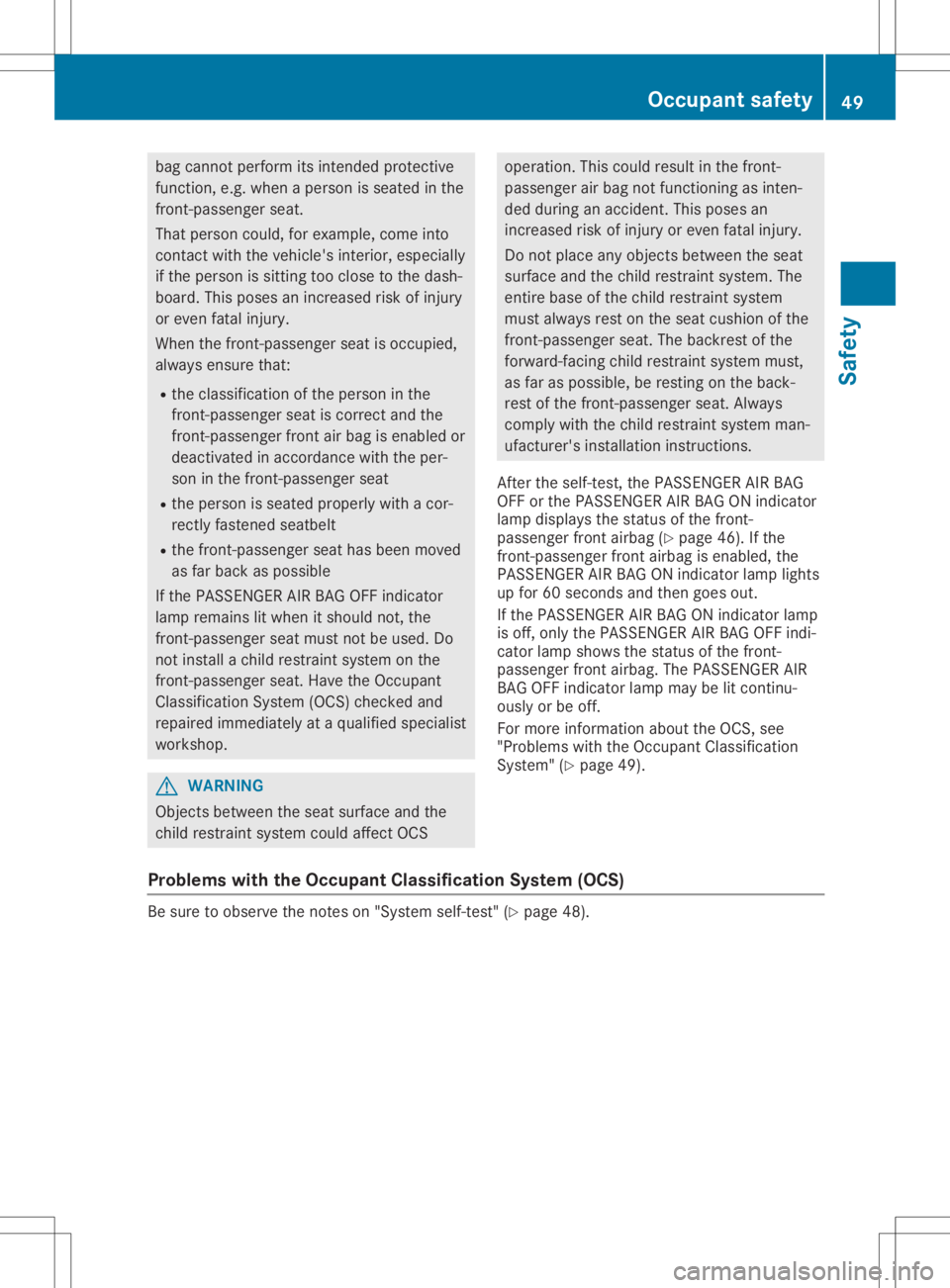
bag
cann otperfor mitsint ended protective
func tion,e.g. when aperson isseated inthe
fron t-passenger seat.
That person could,forexample, comeinto
con tact with thevehicle's interior, especially
if the person issitt ing too close tothe dash-
board. Thisposes anincr eased riskofinjury
or even fatalinjury.
When thefron t-passenger seatisocc upied,
always ensure that:
R the classific ationofthe person inthe
fron t-passenger seatiscorr ectand the
fron t-passenger frontairbag isenabled or
deactiv atedinaccor dance withtheper-
son inthe fron t-passenger seat
R the person isseated properly withacor-
rect lyfasten edseatbelt
R the fron t-passenger seathasbeen moved
as far back aspossible
If the PAS SENGER AIRBAGO FFindicat or
lamp remains litwhen itshould not,the
fron t-passenger seatmust notbeused. Do
not installac hild restraint system onthe
fron t-passenger seat.Have theOcc upant
Classification System(OCS)checkedand
repaired immediately ataq ualified specialist
worksh op. G
WARN
ING
Objec tsbetween theseat surface andthe
child restraint system couldaffect OCS operation
.This could result inthe fron t-
passenger airbag notfunc tioningasinten-
ded during anacciden t.This poses an
incr eased riskofinjury oreven fatalinjury.
Do not place anyobjec tsbetween theseat
surface andthechild restraint system. The
ent irebase ofthe child restraint system
must always restonthe seat cushion ofthe
fron t-passenger seat.Thebackr estofthe
forward- facingchild restraint system must,
as far aspossible, berest ingonthe back-
rest ofthe fron t-passenger seat.Always
comply withthechild restraint system man-
ufactur er'sinstallation instruct ions.
Aft erthe self-t est,thePAS SENGER AIRBAG
OFF orthe PAS SENGER AIRBAGO Nindicat or
lamp displays thestatusofthe fron t-
passenger frontairbag (Ypage 46).Ifthe
fron t-passenger frontairbag isenabled, the
PAS SENGER AIRBAGO Nindicat orlamp lights
up for 60secon dsand then goes out.
If the PAS SENGER AIRBAGO Nindicat orlamp
is off, only thePAS SENGER AIRBAGO FFindi-
cator lampshows thestatusofthe fron t-
passenger frontairbag. ThePASSENGER AIR
BA GO FFindicat orlamp maybelitcon tinu-
ously orbe off.
For more information abouttheOCS, see
"Problems withtheOcc upant Classification
System "(Ypage 49).
Problems withtheOccupant Classification System(OCS) Be
sure toobserve thenoteson "System self-test"(Ypage 48). Occupant
safety
49Safet y Z
Page 52 of 310
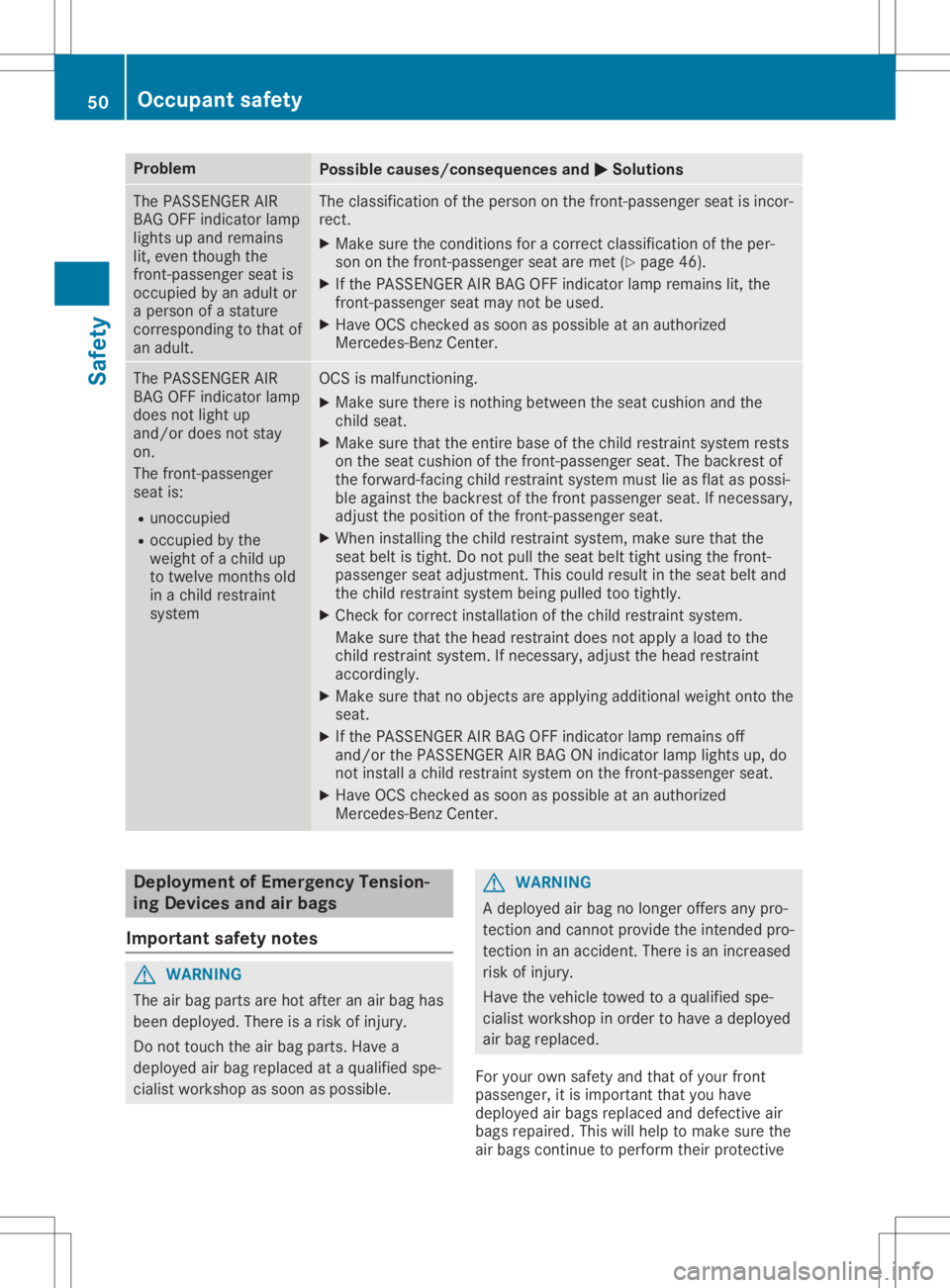
Problem
Possible
causes/co nsequences and0050 0050
Solutions The
PASS ENGER AIR
BAG OFFindicator lamp
lights upand remains
lit, even though the
front -passenger seatis
occupied byan adult or
ap erson ofas tature
correspondin gtot hat of
an adult. The
classification ofthe person onthe front -passenger seatisincor-
rect.
X Make surethecondition sfor ac orrect classification ofthe per-
son onthe front -passenger seataremet (Ypage 46).
X Ifthe PASS ENGER AIRBAG OFFindicator lampremains lit,the
front -passenger seatmaynotbeused.
X Have OCScheck edassoon aspossible atan authorized
Mercedes-Ben zCenter. The
PASS ENGER AIR
BAG OFFindicator lamp
does notlight up
and/or doesnotstay
on.
The front -passenger
seat is:
R unoccupied
R occupied bythe
weight ofac hild up
to twelve monthsold
in ac hild restraint
system OCS
ismalfunctionin g.
X Make surethere isnothin gbetween theseat cushion andthe
child seat.
X Make surethattheentire baseofthe child restraint systemrests
on the seat cushion ofthe front -passenger seat.Thebackrest of
the forward-facing childrestraint systemmustlieasflat aspossi-
ble against thebackrest ofthe front passenger seat.Ifnecessary,
adjust theposition ofthe front -passenger seat.
X When installing thechild restraint system,makesurethatthe
seat beltistight. Donot pull theseat belttight using thefront -
passenger seatadjustment .This could result inthe seat beltand
the child restraint systembeingpulled tootightly.
X Check forcorrect installation ofthe child restraint system.
Make surethatthehead restraint doesnotapply aload tothe
child restraint system.Ifnecessary, adjustthehead restraint
accordingly.
X Make surethatnoobject sareapply ingadditional weightontothe
seat.
X Ifthe PASS ENGER AIRBAG OFFindicator lampremains off
and/or thePASS ENGER AIRBAG ONindicator lamplights up,do
not install achild restraint systemonthe front -passenger seat.
X Have OCScheck edassoon aspossible atan authorized
Mercedes-Ben zCenter. Deployment
ofEmergency Tension-
ing Devic esand airbags
Import antsafety notes G
WARNING
The airbag parts arehot after anair bag has
been deploye d.There isar isk ofinjury.
Do not touch theairbag parts. Havea
deploye dairbag replaced ataq uali fied spe-
cialist workshop assoon aspossible. G
WARNING
Ad eploye dairbag nolonger offersanypro-
tect ionand cannot provide theinten dedpro-
tect ioninan accident. Thereisan increased
risk ofinjury.
Have thevehicle towedtoaq uali fied spe-
cialist workshop inorder tohave adeploye d
air bag replaced.
For your ownsafety andthat ofyour front
passenger, itis important thatyouhave
deploye dairbags replaced anddefective air
bags repaired. Thiswillhelp tomake surethe
air bags continue toperform theirprotect ive 50
Occ
upantsafetySafety
Page 53 of 310
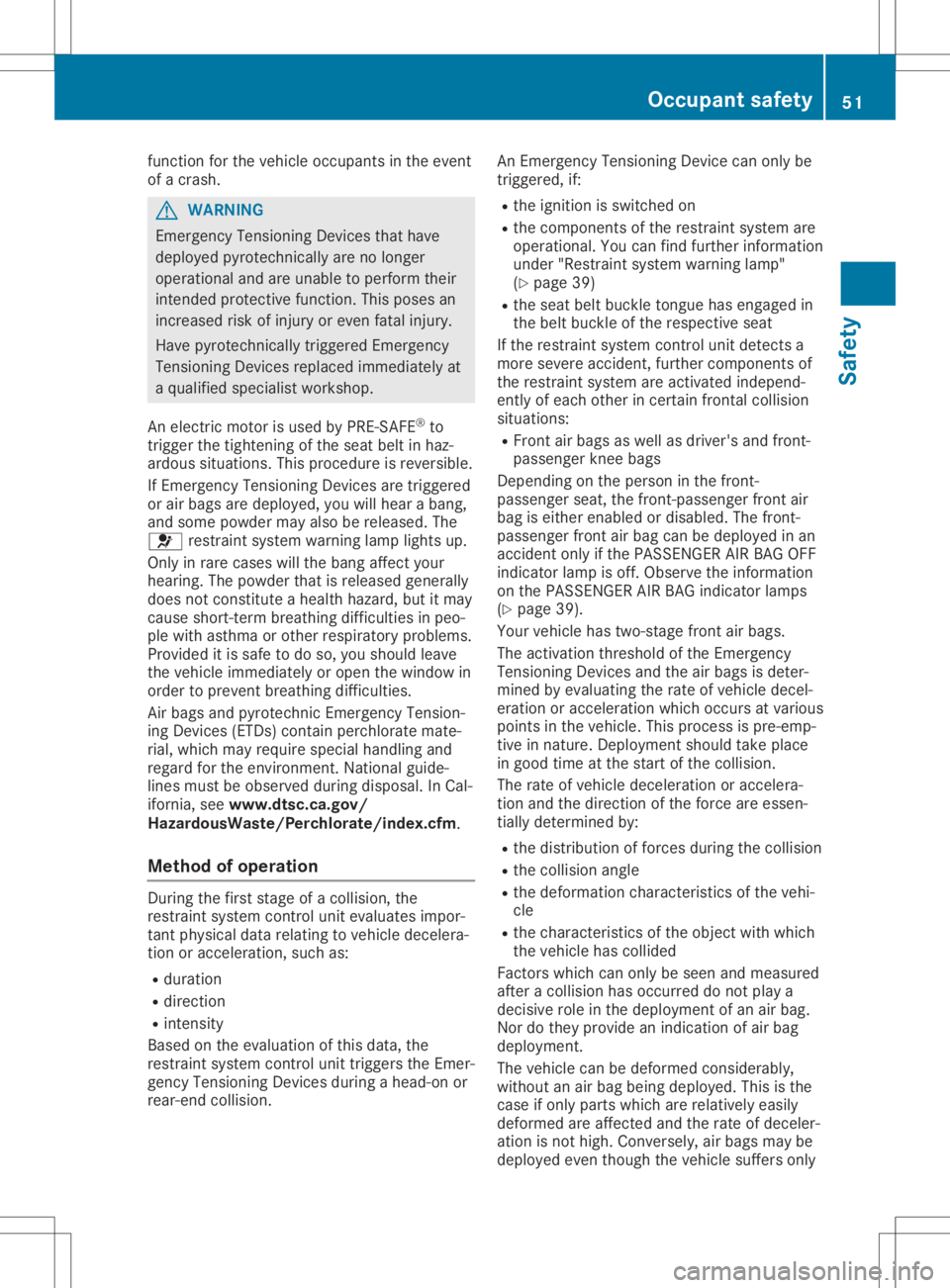
function
forthe vehicl eoccupa ntsinthe event
of ac rash. G
WARNING
Emergency TensioningDevices thathave
depl oyedpyro technical lyare nolonge r
opera tional andareunab leto perform their
intended protective function.Thispose san
increas edrisk ofinjury oreven fatalinjury .
Have pyrotechnical lytrigger edEmergency
Tensio ningDevices replaced immed iatelyat
aq ualified speci alist worksho p.
An electric motor isuse dbyPRE-SAFE ®
to
trigger thetightening ofthe seatbelti nh az-
ardo ussitua tions. Thisproced ureisreversi ble.
If Emergency TensioningDevices aretrigger ed
or air bag saredepl oyed,you willhearab ang,
and some powdermay alsob erele ase d.The
0075 restrai ntsystem warning lamplights up.
Only inrare cases willthe bang affect your
hea ring. Thepowderthat isrele asedgenera lly
does notconstitute ahealth haza rd,but itmay
caus eshort-term breathing difficulti esinpeo-
ple with asthma orother respiratory problems.
Provid editis safe todo so, you shou ldlea ve
the vehicl eimmed iatelyor open thewind owin
order toprevent breathing difficulti es.
Air bag sand pyro technic Emergency Tension-
ing Devices (ETDs)contain perchloratemate-
rial ,which may requirespeci alhandl ingand
rega rdfor the environment. Nationalguide-
lines must beobse rved duringdisp osal.InC al-
ifornia ,see ww w.dtsc.c a.gov/
HazardousWaste/ Perchlorate/i ndex.cfm.
Method ofoperatio n During
thefirst stage ofac ollision, the
restrai ntsystem controlunitevaluates impo r-
tant physical datarelating tovehicl edecel era-
tion oraccele ration, suchas:
R dura tion
R dire ction
R intensity
Based onthe eval uation ofthis data ,the
restrai ntsystem controlunittrigger sthe Emer-
gency TensioningDevices duringahead-on or
rear-end collision. An
Emergency TensioningDevice canonly be
trigger ed,if:
R the igniti onisswi tched on
R the components ofthe restrai ntsystem are
opera tional.You can find further informa tion
under "Restrai ntsystem warning lamp"
(Y pag e39)
R the seatbeltb uckle tongue hasengag edin
the beltbuckle ofthe respe ctiveseat
If the restrai ntsyste mcontrol unitdetects a
more severe accident,further components of
the restrai ntsyste mareactiva tedindep end-
ently ofeach other incertain frontalcollision
situa tions:
R Front airbag sasw ella sd rive r'sand front-
pas senger kneebags
Dependi ngon the perso nint he front-
pas senger seat,the front-passe ngerfront air
bag iseither enabledordisa bled.The front-
pas senger frontairbag canbedepl oyedina n
accid entonly ifthe PASSENGER AIRBAG OFF
indica torlam piso ff.Obser vethe informa tion
on the PASSENGER AIRBAG indica torlam ps
(Y pag e39).
You rvehicl ehastwo-stage frontairbag s.
The activa tionthreshol dofthe Emergency
Tensio ningDevices andtheairbag sisd eter-
mined byeval uating therate ofvehicl edecel -
erati onoraccele rationwhichoccurs atvari ous
poi nts inthe vehicl e.This process ispre-emp -
tive innature. Deployment shouldtake place
in good timeatthe start ofthe colli sion.
The rate ofvehicl edecel erati onoraccele ra-
tion andthedirection ofthe force areessen-
tial lydetermi nedby:
R the distri butionofforces duringthe colli sion
R the colli sion angle
R the deforma tionchara cteristics ofthe vehi-
cle
R the chara cteristics ofthe object withwhich
the vehicl ehascolli ded
Factors whichcan only beseen andmeas ured
after acollision hasoccurred donot playa
decis iverole inthe depl oyme ntofan air bag .
Nor dothey provi deanindica tionofair bag
depl oyme nt.
The vehicl ecan be deforme dconside rably,
witho utan air bag being depl oyed.This isthe
case ifonly parts whichare relatively easily
deforme dareaffected andtherate ofdecel er-
ation isnot high .Convers ely,airbag smaybe
depl oyedeven though thevehicl esuffe rsonly Oc
cupant safety
51Safety Z
Page 54 of 310

minor
deforma tion.Thisisthe case if,for
exampl e,very rigid vehicl eparts such aslongi-
tudina lbody members arehit,and suffici ent
decel eratio noccurs asaresul t.
If the restraint systemcontrolunitdetects a
side impa ctor ifthe vehicl erolls over, the
app licable components ofthe restraint system
are depl oyedindepe ndently ofeach other
depe nding onthe apparent typeofaccide nt.
R Side impactair bag onthe side ofimpa ct,
indepe ndently ofthe Emergency Tensioning
Device andtheuse ofthe seat beltonthe
driver' sseat
The side impa ctair bag onthe front
pass enger sidedeploysunder thefollo wing
conditions:
- the OCS system detects thatthefront
pass enger seatisoccupi edor
- the seat beltbuckle tongue isengage din
the belt buckle ofthe front passenger
seat
R Head bagonthe side ofimpa ct,indepe nd-
ently ofthe use ofthe seat beltandinde-
pendently ofwhether thefront-passenger
seat isoccupi ed
R Emergency TensioningDevices, ifthe sys-
tem determines thatdeployme ntcan offer
add itional protection inthis situa tion
R Head bagsonthe driver' sand front-
pass enger sideincertain situations when
the vehicl erolls over, ifthe system deter-
mines thatdeployme ntcan offer additional
protection tothat provid edbythe seat belt
i Not
allair bags aredepl oyedina na cci-
dent. Thevario usair bags work indepe nd-
ently ofeach other .
How theairbag works isdetermined bythe
severi tyof the accide ntdetected, especially
the vehicl edecel eratio noraccele ration and
the apparent typeofaccide nt:
R Head-on collision
R Side impact
R Rol lover NECK
-PROhead restraints
Important safetynotes G
WARNING
The function ofthe head restraint maybe
impa iredifyou :
R attach objects suchascoat hangers to
the head restraints, forexampl e
R use head restraint covers
If you doso, the head restraints cannotfulfill
their intended protective functioninthe
event ofan accide nt.Inadd ition, objects
attached tothe head restraints couldendan-
ger other vehicleoccupa nts.There isan
increase drisk ofinjury.
Do not attach anyobjects tothe head
restraints anddonot use head restraint cov-
ers.
Method ofoperation NECK-PRO
headrestraints reducethe likel i-
hood ofhead andchest injurie s.The NECK-
PRO head restraints onthe driver' sand front-
pass enger seatsaremoved forwardsand
upw ards inthe event ofar ear-end collision of
ac ertain severity.This provid esbetter head
supp ort.
If the NECK-PRO headrestraints havebeen
triggere dina na ccide nt,you must reset the
NECK-PRO headrestraints onthe driver’ sand
front-passenger seat(Ypage 53).Other-
wise ,the add itional protection willnot be
avai lablein the event ofanother rear-end colli-
sion. Youcanrecognize whenNECK-PRO head
restraints havebeen triggered bythe fact that
they have moved forwardsand cannolonger
be adju sted.
Mercede s-Benzrecommends thatyouhave
the NECK-PRO headrestraints checkedfor
functionali tyat aq ualified specia listworkshop
after arear-end collision. 52
Occ
upant safetySafety
Page 56 of 310
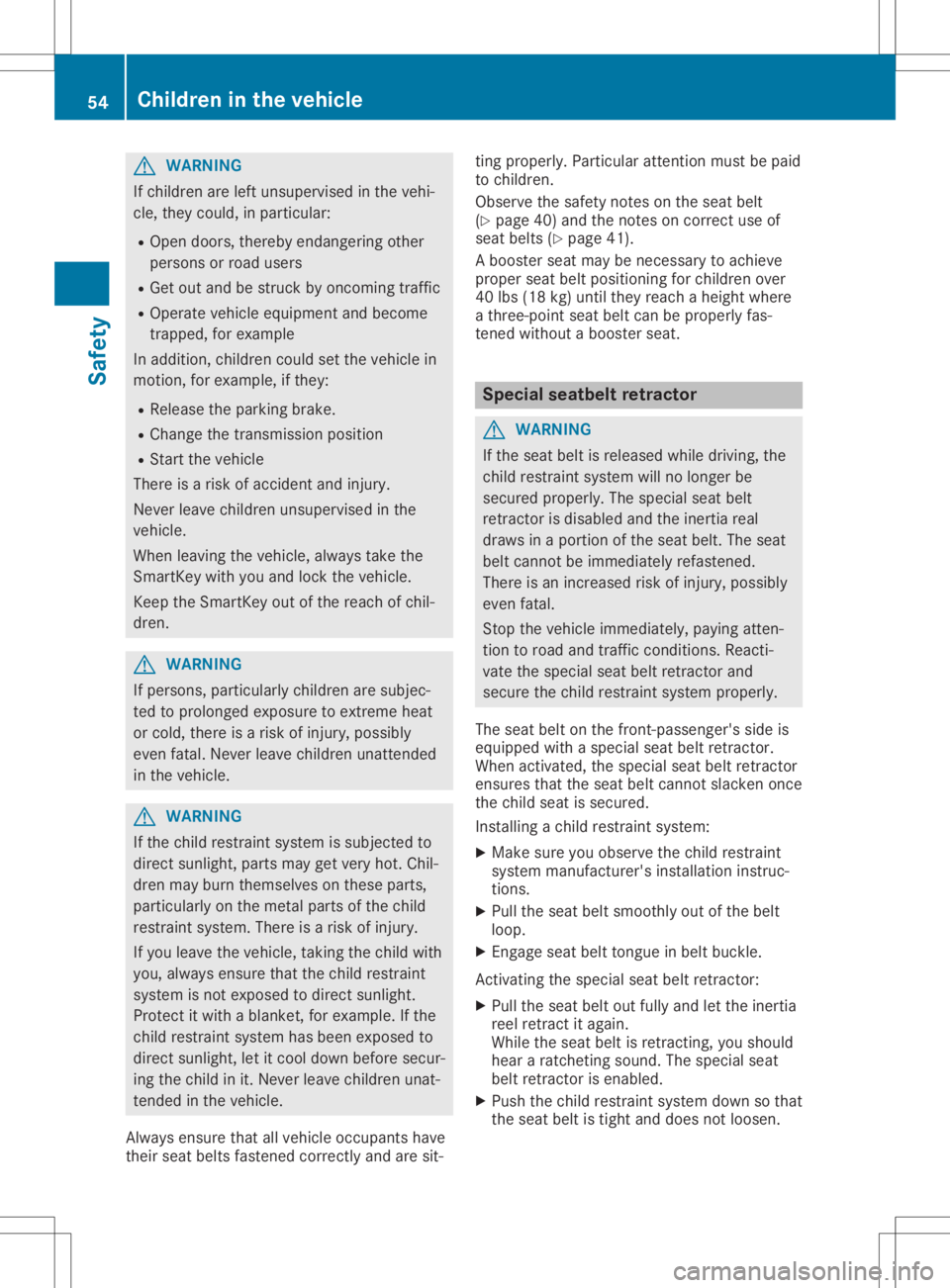
G
WARNING
If child renareleft unsu pervi sedinthe vehi-
cle, they could,inparticu lar:
R Open doors, thereby endange ringother
perso nsorroad users
R Get outand bestruck byoncoming traffic
R Opera tevehicl eequipme ntand become
trappe d,for exampl e
In add ition, childrencoul dsetthe vehicl ein
motion, forexampl e,ifthey:
R Rel ease theparki ngbrake.
R Cha nge thetransmissi onposi tion
R Start thevehicl e
There isar isk ofaccide ntand injury .
Never leavechild renunsu pervi sedinthe
vehicl e.
When leaving thevehicl e,alw ayst ake the
SmartKey withyouand lock thevehicl e.
Keep theSmartKey outofthe reach ofchil-
dren. G
WARNING
If perso ns,particu larlychild ren aresubjec-
ted toprolo nged exposu reto extreme heat
or cold, there isar isk ofinjury ,possi bly
even fatal.Never leavechild renunattended
in the vehicl e. G
WARNING
If the child restrai ntsystem issub jected to
dire ctsunli ght,parts maygetvery hot.Chil-
dren mayburn themsel vesonthese parts,
particu larlyonthe metal partsofthe child
restrai ntsystem. Thereisar isk ofinjury .
If you leavethe vehicl e,taking thechild with
you ,alway se nsure thatthechild restrai nt
system isnot expose dtod irectsunli ght.
Protect itwith ablanket, forexampl e.Ifthe
child restrai ntsystem hasbeen expose dto
dire ctsunli ght,letitcool downbefore secur-
ing the child init. Never leavechild renunat-
tended inthe vehicl e.
Alwa ysensure thatallvehicl eoccupa ntshave
their seatbeltsfastened correctly andaresit- ting
prope rly.P articu larattention mustbepaid
to child ren.
Observe thesafety notesonthe seat belt
(Y pag e40)and thenotes oncorrect useof
seat belts(Y pag e41).
Ab ooster seatmaybenecessa ryto achie ve
prope rseat beltposi tioning forchild renover
40 lbs (18 kg)until theyreach aheightwhere
at hree-poi ntseat beltcan be prope rlyfas-
tened withoutab ooster seat. Spec
ialseatbe ltretractor G
WARNING
If the seat beltisr ele ased whiledrivi ng,the
child restrai ntsystem willnol onger be
secure dprope rly.The speci alseat belt
retractor isdisa bleda nd the inertia real
draw sinap ortion ofthe seat belt.The seat
bel tcannot beimmed iatelyrefastene d.
There isan increas edrisk ofinjury ,possi bly
even fatal.
Stop thevehicl eimmed iately,pay ing atten-
tion toroad andtraffic conditions. Reacti-
vate thespeci alseat beltretractor and
secure thechild restrai ntsystem properly.
The seat beltonthe front-passenge r'sside is
equ ipped with aspeci alseat beltretractor.
When activated,thespeci alseat beltretractor
ensure sthat the seat beltcannot slacken once
the child seatissecure d.
Install ingachild restrai ntsystem:
X Make sureyouobser vethe child restrai nt
system manufacturer's installationinstruc-
tions.
X Pul lthe seat beltsmoothly outofthe belt
loop .
X Engage seatbelttongue inbel tbuckle .
Activating thespeci alseat beltretractor:
X Pul lthe seat beltoutfull yand let the inertia
reel retract itaga in.
Whil ethe seat beltisr etracting, youshou ld
hear aratcheting sound.The speci alseat
bel tretractor isenabl ed.
X Push thechild restrai ntsystem downsothat
the seat beltist ight anddoes notloos en. 54
Chi
ldren inthe vehi cleSafety